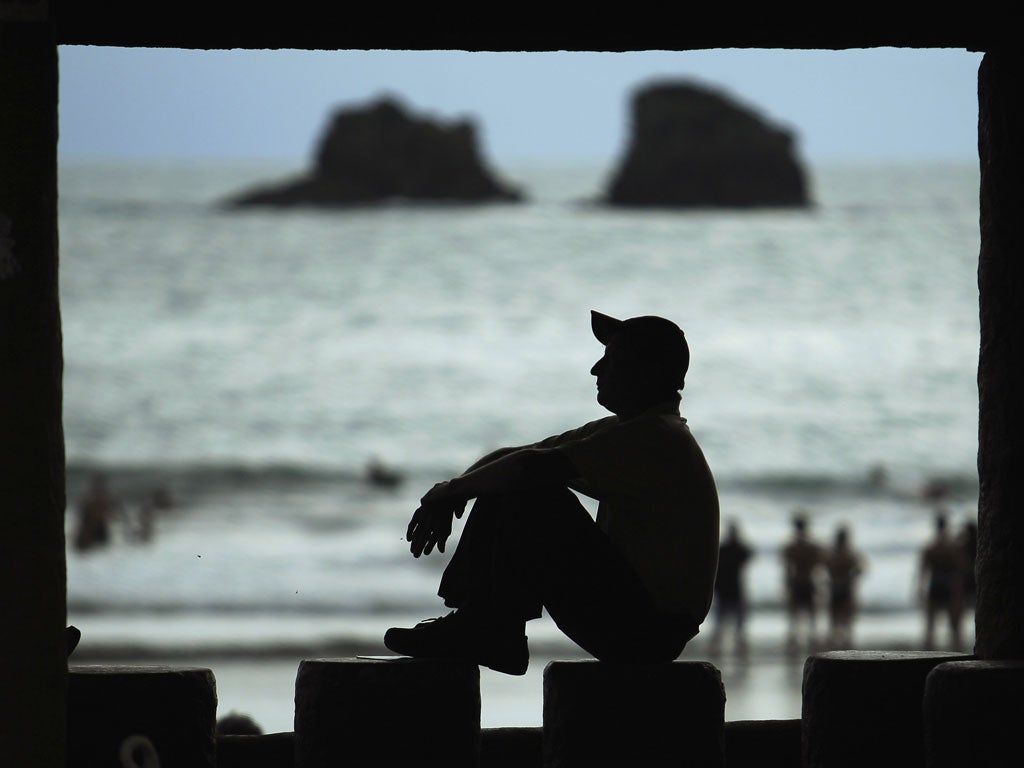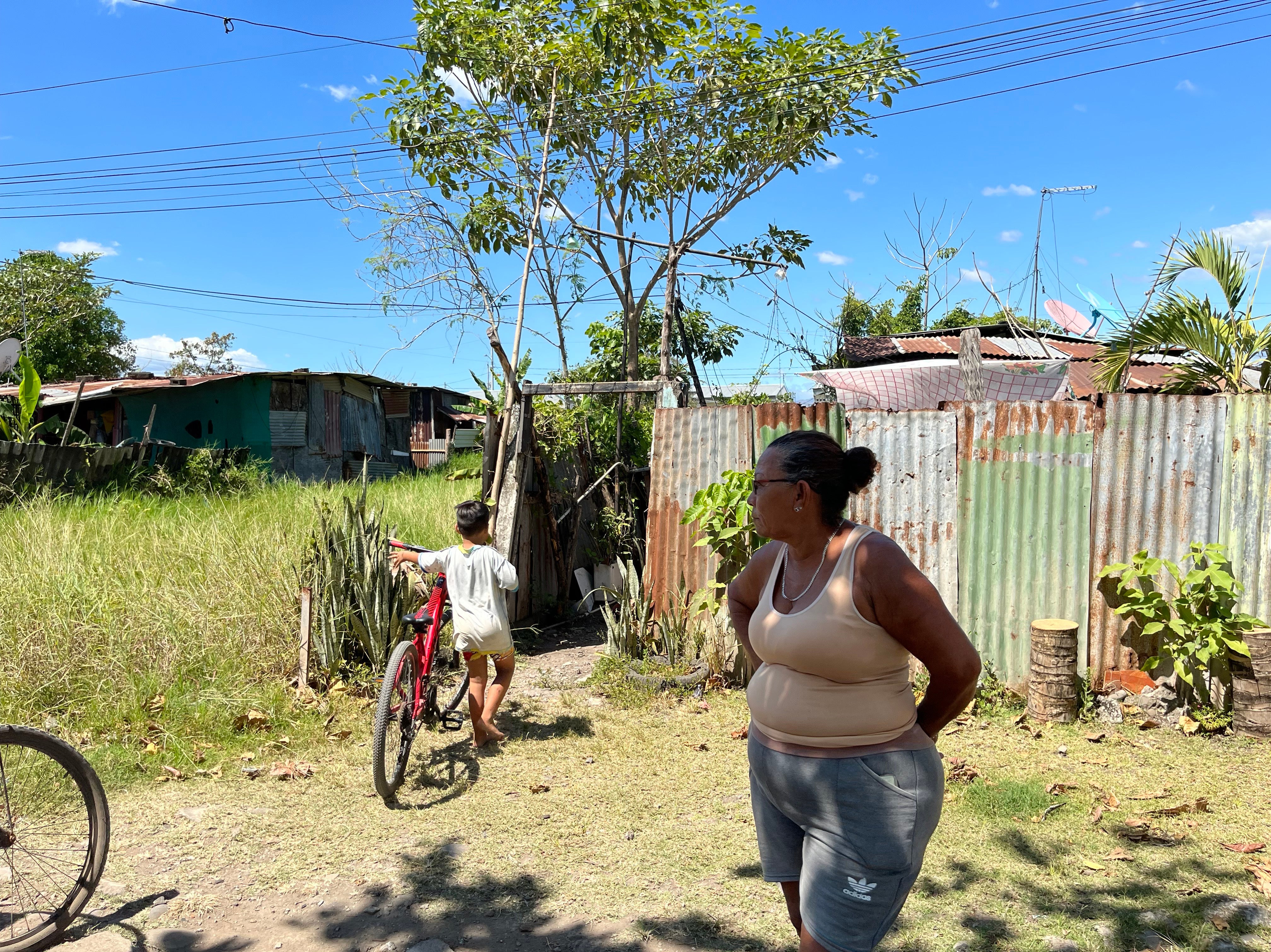Costa Rica, laidback land of ‘pura vida’, is facing up to drug violence
Paradise may not be lost, but a lot of the people living there are, writes Mary Beth Sheridan

All was quiet that night on the Promenade of the Tourists, the famed boulevard overlooking this coastal city’s white-sand beach and softly lapping waves. But just a few miles from the bars and seafood cafes, Maribel Sandi was startled awake by rapid-fire, metallic bursts.
The 59-year-old grandmother emerged from her corrugated metal shack. It was dark, past 11pm, a muggy January night. Here, in the Bella Vista area, where young people sell scrap metal to buy crack, neighbours had gathered on the dirt road.
“There was a dead man,” Sandi says. The 21-year-old’s body had been “ripped apart” by a barrage from AK-47 assault rifles.
“We had never seen that,” she says.
Costa Rica has long been a model of progressive democracy in Latin America, a nation that abolished its army in 1948 and set aside a quarter of its territory for conservation. Hundreds of thousands of American and European tourists fly in annually to surf, hike the pristine rainforests and enjoy the laidback pura vida vibe.
Now, this longtime refuge of tranquility is grappling with a jump in violence, driven by a little-remarked-on phenomenon that is bedeviling several Latin American countries. Once merely way stations for illegal drugs heading to the United States or Europe, they are suffering abuse problems of their own.
Costa Rica is just one example. Farther north, in Mexico, cartels that pump out methamphetamines for Americans also are feeding a growing domestic market. The number of Mexicans being treated for amphetamine addiction – mostly involving meth – ballooned by 218 per cent from 2013 to 2020, according to the latest UN World Drug Report.
In South America, the number of people using cocaine more than doubled in a decade, reaching an estimated 4.7 million people in 2020, the UN Office on Drugs and Crime reported. Consumption was particularly high in Brazil, Uruguay, Ecuador and Argentina, key transshipment points for Europe-bound cocaine.
Rising drug use does not always lead to more violence. But in some countries, battles over street sales have fuelled an increase in bloodshed. Ecuador’s homicide rate tripled between 2020 and 2022 as drug groups fought over domestic sales as well as export routes. Costa Rica suffered a record 656 homicides last year, up 12 per cent from 2021. In Mexico, disputes between dealers selling crystal meth have sent death tolls soaring in cities including Tijuana, Juárez and Manzanillo.

“The problem has come home to roost,” Laura Chinchilla, a former president of Costa Rica, says. “Our own people are using drugs and making it possible for these crime groups to exist.”
The major Mexican and Colombian trafficking organisations have little presence in Costa Rica. But for years, local criminals have provided logistical support, such as petrol and motorboats, for the big cartels that move cocaine from Colombia to the United States and Europe.
At some point, the cartels began paying these low-level contractors in drugs. Many began selling that cocaine or turning it into cheap crack, creating local demand.
Small-scale drug feuds are behind the majority of homicides in Puntarenas, one of Costa Rica’s seven provinces. “Most of those killed are kids,” says Randall Picado, the top police official in the region.
One recent afternoon, Picado pulled his truck over on the Promenade of the Tourists. Down the street, visitors boarded ferries heading to some of the country’s most magnificent beaches. In front of him, across the glittering Pacific, was the hazy outline of the Nicoya Peninsula, where celebrities including Mel Gibson, Matt Damon and Tom Brady have holidayed. Picado rarely has to worry about crime there.
“The problem is focused in the barrios,” the poor inland neighbourhoods, he says. “Not in the tourist zones.”
We continue to live practically with the same anti-drug policy we designed 30 years ago
Nonetheless, Costa Ricans are anxious. The country’s security minister made headlines in December when he appeared to praise the ruthless anti-gang policies of El Salvador’s president, Nayib Bukele. The Costa Rican government scrambled to clarify that it was not planning anything similar to Bukele’s mass round-ups and indefinite detention of suspects – although some politicians applauded the idea.
The expanding drug-addiction crises in Latin America are exacerbated by a lack of professional police, effective judicial systems and treatment facilities. So far, there has been little hemispheric coordination to address the problem, says Chinchilla, who has remained a prominent voice on security issues since leaving the presidency in 2014.
In one sign of the disorganisation, she says, countries such as Costa Rica are spending limited resources busting marijuana shipments. At the same time, the United States – home to the western hemisphere’s largest narcotics market – is starting to legalise the drug.
“We continue to live practically with the same anti-drug policy we designed 30 years ago,” she says.
Maribel Sandi remembers the moment her community hit breaking point. It was 22 March 2021, a Monday afternoon. Some children had been playing football nearby. At the edge of the crumbling tarmac pitch, they found a big black bin bag.
Inside was a human head.
Taylor Castro, a 20-year-old man from Bella Vista, had been decapitated, apparently by a rival gang.
“That’s where it all began,” Sandi says.
Bella Vista is just six miles from the Promenade of the Tourists, but the two places are a world apart. Families here bake in sweltering shacks with corrugated metal roofs. Children ride by on battered bikes, kicking up clouds of dust.
Sandi knew that drug abuse had been rampant for years – crack, marijuana, illicitly traded prescription pills such as clonazepam. Violence was hardly unusual. But a beheading?

Through her work leading a shrimp-peelers’ collective, Sandi had met Denia Murillo, the local representative of Costa Rica’s social welfare agency. Sandi fired off a text.
“I said, ‘Doña Denia, let’s do something, to help the children.’”
What followed was an outpouring of civic activity known as the Strategy. Murillo persuaded Costa Rica’s federal institutions to focus on rehabilitating Puntarenas’s poorest communities – organising youth sporting events, theatre clubs, parenting classes, citizen safety patrols. The US embassy pitched in through its programme Sembremos Seguridad (“Let’s Sow Security”).
But the Costa Rican government provided few additional resources, Murillo says. The gang battles continued, with one young man after another felled by gunfire. The Strategy lost momentum.
Puntarenas was just one of many areas caught up in a much larger problem: cocaine production in Colombia was exploding. Global cocaine output shot to a record high in 2021, the UN Office on Drugs and Crime reports. Costa Rican officials caught a glimpse of that boom by way of their cocaine seizures, which increased fivefold over a decade, reaching 49 tons in 2021.
Most of it was destined for other countries. Still, “it’s not at all unusual that traffic leads to consumption” at the local level, says Antoine Vella, a top data official at the UN agency. “We call it the spillover effect.”
Cocaine and crack have overtaken marijuana as the second most common category of substances for which Costa Rican addicts are receiving treatment, after alcohol. “Cocaine has become a protagonist,” says Helvethya Alfaro, a senior official of the government’s Institute of Alcoholism and Drug Addiction.
Security officials have been blasting judges for releasing gang suspects to house arrest, monitored by ankle bracelets, saying such practices belong to a more peaceful past
Officials note that Costa Rica is still less violent than many countries in the region. Its homicide rate hit 12.6 per 100,000 people last year. In Mexico, the rate is 25 per 100,000; in Honduras, it’s 36. (The most recent US figure is about 7 per 100,000). And although an increasing number of homicides in Costa Rica involve handguns, assault rifles are still rare.
“Paradise isn’t lost,” says Randall Zuñiga, the head of the Judicial Investigation Department, the rough equivalent of the FBI.
Gema Kloppe-Santamaria, a professor at George Washington University who studies violence in Latin America, warns against shrugging off the homicides as disputes between gangs: “That went very wrong for Mexico.” Mexican authorities initially underestimated the impact of an explosion of bloodshed 15 years ago and are struggling to regain control.
Chinchilla, the former president, says that the rising violence could push a jittery public toward the populist policies of a Bukele type, eroding the nation’s democratic heritage. A UN-sponsored study released in October found that two-thirds of Costa Ricans felt their country was somewhat or very unsafe.
President Rodrigo Chaves, who took office nearly a year ago, is promising to send “urgent legal reforms” on gun control, extradition, phone tapping and preventive detention to Congress next month. Security officials have been blasting judges for releasing gang suspects to house arrest, monitored by ankle bracelets, saying such practices belong to a more peaceful past.
“We didn’t have the reality that we have right now,” deputy security minister Daniel Calderón says.
But the courts are not the only concern. Budget cuts in recent years have weakened the police force. Now, Calderón says, a shift is underway “to concentrate not just on international drug trafficking but also on attacking these local gangs”.
In Bella Vista, that approach is evident. After the 21-year-old man was gunned down in January, police swarmed the neighbourhood, a helicopter swooping in and an armoured vehicle known as “the Beast” trundling along the potholed roads. “We called it a war,” Sandi says.

Even the police acknowledge that aggressive law enforcement alone will not solve the problem. Sandí says a lack of well-paying jobs and educational support is pushing young people into the vortex of illegal drugs. The coronavirus pandemic battered Costa Rica’s tourist economy, and unemployment still hovers around 12 per cent. Public services in the country of 5 million have been strained by the arrival of waves of migrants fleeing an increasingly dictatorial government in neighboring Nicaragua.
In vulnerable areas, drugs have become an escape, Sandi says. “It’s as if you forget your problems a little bit. Nothing else matters – just using.”
She knows the feeling well. Years ago, she says, she walked out on an abusive husband and struggled to support her three children. She wound up leaving them with her mother while she worked as a nanny. She tried her first drink – half a bottle of beer – at a bar with an acquaintance. Soon she was downing six or seven. Next, it was marijuana.
“Then the white powder came. People called it cocaine,” she says. She ended up addicted to crack. “You felt like your head was going to explode, but it was so beautiful.” Above all, it was the thing that made the pain go away.
“I thought no one loved me. Not even my mother.”
She was saved by prayer and her Christian faith, she says. But for her neighbourhood, in the grip of a drug crisis, salvation seems remote.
“Many of the young people here,” she says, “are lost.”
© The Washington Post






Join our commenting forum
Join thought-provoking conversations, follow other Independent readers and see their replies
Comments